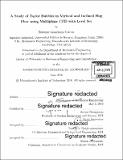A study of Taylor bubbles in vertical and inclined slug flow using multiphase CFD with level set
Author(s)
Lizarraga-García, Enrique
DownloadFull printable version (24.23Mb)
Other Contributors
Massachusetts Institute of Technology. Department of Mechanical Engineering.
Advisor
Jacopo Buongiorno.
Terms of use
Metadata
Show full item recordAbstract
Slug flow commonly occurs in gas and oil systems. Current predictive methods are based on mechanistic models, which require the use of closure relations to complement the conservation equations to predict integral flow parameters such as liquid holdup (or void fraction) and pressure gradient. These closure relations are typically developed either empirically or from semi-empirical models assuming idealized geometry of the interface, thus they carry the highest uncertainties in the mechanistic models. In this work, sensitivity analysis has determined that Taylor bubble velocity in slug flow is one such closure relation which significantly affects the calculation of these parameters. The main objective is to develop a unified higher-fidelity closure relation for Taylor bubble velocity. Here, we employ a novel approach to overcome the experimental limitations: validated 3D Computational Multiphase Fluid Dynamics (CMFD) with Interface Tracking Methods (ITMs) where the interface is tracked with a Level-Set method implemented in the commercial code TransAT®. In the literature, the Taylor bubble velocity is modeled based on two different contributions: (i) the drift velocity, i.e., the velocity of propagation of a Taylor bubble in stagnant liquid, and (ii) the liquid flow contribution. Here, we first analyze the dynamics of Taylor bubbles in stagnant liquid by generating a large numerical database that covers the most ample range of fluid properties and pipe inclination angles explored to date (Eo [epsilon] [10, 700], Mo [epsilon] [1 . 10-6, 5 . 103], and [theta] [epsilon] [0°, 90°]). A unified Taylor bubble velocity correlation, proposed for use as a slug flow closure relation in the mechanistic model, is derived from that database. The new correlation predicts the numerical database with 8.6% absolute average relative error and a coefficient of determination R² = 0.97, and other available experimental data with 13.0% absolute average relative error and R² = 0.84. By comparison, the second best correlation reports absolute average relative errors of 120% and 37%, and R² = 0.40 and 0.17, respectively. Furthermore, two key assumptions made in the CMFD simulations are justified with simulations and experiments: (i) the lubricating liquid film formed above the bubble as the pipe inclines with respect to the horizontal does not breakup, i.e., the gas phase never touches the pipe wall and triple line is not formed; and (ii) the Taylor bubble length does not affect its dynamics in inclined pipes. To verify the robustness of the first assumption, the gravity-induced film drainage is analytically modeled and experimentally validated. From this model, a criterion to avoid film breakup is obtained, which holds in the simulations performed. The second assumption is validated with both experiments and simulations. Finally, simulations of Taylor bubbles in upward and downward fluid flow in vertical and inclined pipes are performed, from where it is concluded that an improvement of the current velocity prediction models is needed. In particular, Taylor bubbles in vertical downward flow where the bubble becomes non-axisymmetric at high enough liquid flows are remarkably ill-predicted by current correlations.
Description
Thesis: Ph. D., Massachusetts Institute of Technology, Department of Mechanical Engineering, 2016. Cataloged from PDF version of thesis. Includes bibliographical references (pages 203-220).
Date issued
2016Department
Massachusetts Institute of Technology. Department of Mechanical EngineeringPublisher
Massachusetts Institute of Technology
Keywords
Mechanical Engineering.